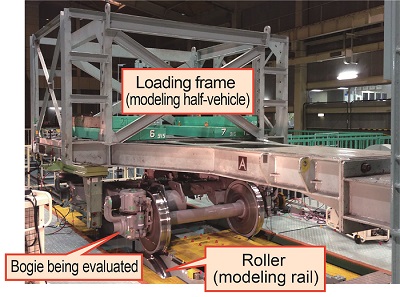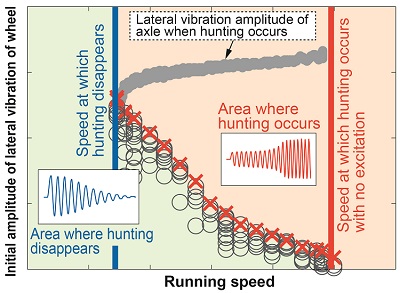8. Increase in accuracy of bogie hunting stability evaluation
It is possible to evaluate the running stability of bogies, or the critical speed of hunting, through rotation tests on a roller using the rolling stock test bench at RTRI (Fig. 1). However, there may be cases where the critical speed of the hunting differs depending on the external trigger used to generate the hunting (excitation conditions applied to the roller), which causes variance in the evaluation results. If the result of an evaluation indicates a sufficiently large safety margin at the in-service running speed, then variance is of no great consequence, however, clarification of the exact conditions that cause hunting, would contribute to making stability evaluations more accurate, so work was done to achieve this.
When the roller speed is gradually increased without any excitation, hunting occurs when a certain speed is reached (hereinafter, ‘generation speed’). Inversely, when the roller is gradually slowed down, hunting will eventually cease at a given speed (hereinafter, ‘disappearance speed’). When the roller is at the speed between the generation and disappearance speeds, whether or not bogie hunting occurs depends on excitation conditions. Various excitation conditions were tried and the behaviors at which hunting actually occurs were clarified experimentally (Fig. 2).
Results revealed that the amplitude value of lateral displacement immediately after excitation ceases (hereinafter, ‘initial amplitude’), has an upper limit within which vibration disappears. Vibrations disappear after excitation stops if the initial amplitude has not reached the peak value (“○” in Fig.2). If the initial amplitude does exceed the peak value (”x” in Fig2.), then vibrations diverge and hunting occurs, and the amplitude of the vibration increases up to the flange contact boundary. The peak value in question decreases monotonically as the roller speed increases from stopping speed to the generation speed.
Conventionally, to compare running stability, excitation conditions were fixed while bogie parameters were varied. Based on the findings of this research, adjusting the input excitation conditions to maintain a constant initial amplitude would prevent variance in the critical speed evaluation values, making comparison possible.
Progress now needs to be made to develop an analytical method that will make it possible to accurately estimate the correlation between running speed and the initial amplitude peak value, with the aim of building an easy-to-use running stability evaluation method that does not require complex fixed rotation tests.
Other Contents
- 1. Earthquake damage simulator for railways with self-correcting function
- 2. Practical application of early earthquake warning method using ocean bottom seismometer data
- 3. Countermeasures to prevent subsidence of abutment backfill and track buckling during earthquakes
- 4. Ground surface layer response evaluation method for very large earthquakes
- 5. Anti-seismic reinforcement method for suspended-ceilings with small cavities at stations
- 6. Algorithm to estimate strong wind locations due to such as gusts.
- 7. Flowchart to determine possibility of reusing bridge following scouring damage
- 8. Increase in accuracy of bogie hunting stability evaluation
- 9. Driver visual recognition support method using image processing
- 10. Health monitoring of very large structures using long-range U-Doppler
- 11. Influence of pinion shaft bearing endplay (axial clearance) on its seizure initiation
- 1. Earthquake damage simulator for railways with self-correcting function
- 2. Practical application of early earthquake warning method using ocean bottom seismometer data
- 3. Countermeasures to prevent subsidence of abutment backfill and track buckling during earthquakes
- 4. Ground surface layer response evaluation method for very large earthquakes
- 5. Anti-seismic reinforcement method for suspended-ceilings with small cavities at stations
- 6. Algorithm to estimate strong wind locations due to such as gusts.
- 7. Flowchart to determine possibility of reusing bridge following scouring damage
- 8. Increase in accuracy of bogie hunting stability evaluation
- 9. Driver visual recognition support method using image processing
- 10. Health monitoring of very large structures using long-range U-Doppler
- 11. Influence of pinion shaft bearing endplay (axial clearance) on its seizure initiation


